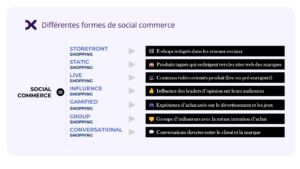Social commerce: An essential pillar of tomorrow’s e-commerce

Fadwa Mennis, Senior Consultant within the Data & Business Consulting practice, primarily involved in e-commerce projects in the Retail sector, shares her vision of social commerce, which has become an essential foundation of today’s and tomorrow’s e-commerce.
Key Takeaways:
Social commerce has become an essential lever for brands to meet and engage their customers, thereby transforming the landscape of e-commerce. Social commerce encompasses all stages of the customer journey and enhances the customer experience through the new features offered by platforms. The development of synergies between teams and the alignment of performance measurement are emerging as key success factors.
Like generative AI, social commerce is frequently cited among the trends that will shape e-commerce growth in 2024. As internet users spend an average of 2 hours and 28 minutes per day on social media, it is natural for brands and retailers to engage with their customers there. Social media has now become an integral part of the digital customer journey for product research, alongside Google and Amazon. The American and Asian markets, ahead of Europe, provide a glimpse of a paradigm shift; social commerce has become a catalyst for the growth of online sales.
Social commerce: a new era for e-commerce
Social commerce involves using social networks to promote and sell products or services online. Popularized by live shopping during the Covid-19 pandemic, social commerce is not limited to that. Structurally, the adoption of social commerce by customers can be explained by the proliferation of smartphones, the time spent on social networks, and the penetration of online sales, all three of which are growing worldwide. Brands and distributors that succeed in positioning social commerce as an accelerator of their online sales do not limit themselves to live shopping but utilize a variety of formats according to their objectives:

Asian markets are pioneers in the adoption of social commerce: in 2023, social commerce accounts for 16% of e-commerce sales in China, with 84% of online shoppers having already made a transaction on social networks. The United States follows closely behind, driven by the dynamism of the tech giants: in 2023, nearly 5% of online sales come from social networks, with 63% of online shoppers having tried this practice. The European market shows similar orders of magnitude, although it is subject to the availability of the latest features from Meta, TikTok, YouTube, and Pinterest: live shopping alone is expected to account for 10% to 20% of e-commerce sales by 2026!
Customers who embrace social commerce appreciate its convenience: social networks facilitate the discovery of new products and the personalization of the customer journey. Fashion items and accessories (40%), beauty products (22%), and furniture (15%) are the most purchased categories worldwide. At the same time, new categories are gaining ground; food, beverages, and household products, for example, have seen significant growth on TikTok in the UK (+4% between 2022 and 2023). The trend indicates that the amount and frequency of transactions by social buyers are increasing more rapidly than their numbers: social commerce thus enables brands to reach audiences with a strong appetite for online shopping. To finalize their orders, these buyers are gradually moving away from being redirected to the brand’s website to experimenting with native checkout on the social network, despite initial concerns regarding transaction security, data collection, or the level of after-sales service.
As a result, social commerce is reshaping the landscape, blurring the boundaries between social networks and e-commerce platforms and making concrete the synergies to be developed between these two realms. For instance, TikTok does not limit its ambition but aims to become a full-fledged e-commerce platform; its transaction volume is expected to quadruple in 2024 to reach $20 billion, driven by free shipping, reduced commissions, and storage space. This ambition is set against a backdrop where marketplaces increasingly dominate the e-commerce landscape (accounting for one-third of e-commerce revenue in Europe in 2023). Conversely, on its e-commerce app, Amazon is testing Inspire, a selection of personalized videos created by influencers that brings the marketplace closer to a true social network.
For an integrated customer experience from social network to e-commerce platform
While social commerce is viewed as a conversion lever, it is important to note that the diversity of its formats actually enables full-funnel activation: from brand awareness to conversion, including engagement and loyalty. As a result, brands and distributors align their social commerce campaigns with targeted advertising investments (paid social ads), which allow them to reach specific and qualified audiences by leveraging CRM data.

The cornerstone of the customer experience in social commerce is, of course, the checkout process. To offer a seamless ordering experience—without redirecting to the brand’s website—social networks aim to make in-app checkout the standard. This was evidenced by the announcement that, by the end of April 2024, brands will need to activate in-app payment options on Meta platforms to continue selling on Instagram and Facebook. This announcement was recently complemented by the partnership between Amazon and Meta, allowing users to place orders with a single click through their Amazon account without leaving Facebook or Instagram. In the same vein, TikTok offers a wide range of services to facilitate operations for brands and distributors through its Seller & Affiliate Center.
Another element of the customer experience in social commerce is affiliation. Brands or distributors can either manage their social commerce activations or delegate the promotion of their products to paid partners within their communities. The market share gains in social commerce for TikTok and YouTube can be attributed to the power of their affiliate networks. Eligible brands validate the content proposed by their partners, where their products are directly featured, and compensate them based on the sales volume generated.
Scaling Up to Address the Challenges of Social Commerce
Within an organization, social commerce involves teams responsible for media (as activations generally require investments to increase organic reach) and digital (which directly contributes to online sales). Aware of this orchestration challenge, social networks provide advanced features to facilitate this process. For example, TikTok’s live shopping, one of the most effective formats, allows brands to showcase a product live, pin it on screen for easy cart addition, invite influencers to broaden their audience, and even add live moderators to manage interactions. Additionally, a variety of external partners and technological solutions are available to automate all or part of the operations.
To develop synergies between e-commerce platforms and social networks, teams must align on measuring and tracking social commerce performance. In addition to the data available on social networks, Meta’s Conversion API reconciles a visitor’s behavior on Facebook or Instagram with their actions on the brand’s e-commerce site, paving the way for more precise measurement of social commerce’s attribution and contribution to total online sales. Finally, Marketing Mix Modeling (MMM) allows for a precise comparison of the return on investment from social commerce with all other activated marketing levers.
Converteo supports its clients worldwide in defining their social commerce strategy, implementing best practices associated with technological choices, and operationally monitoring their campaigns.
Sources :
- Statista, “Où passe-t-on le plus de temps sur les réseaux sociaux ?”, 2022
- Statista, “Social commerce sales value in e-commerce in China from 2019 to 2025”, 2022
- Insider Intelligence, “US Social Commerce Buyers – 2019-2025”, 2022
- Statista, “Share of online consumers buying from social networks in 2022”, 2022
- BrainValue, “Social commerce quantitative report”, 2022
- Fox Intelligence, “Key e-commerce trends in Europe in 2024”, 2024
- Insider Intelligence, “TikTok bets big on livestream commerce”, 2023

